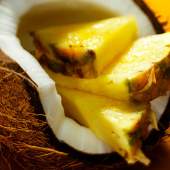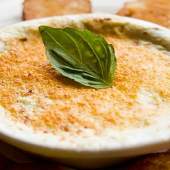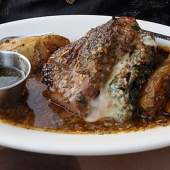The Casserole

“A good marriage is like a casserole – only those responsible for it really know what goes in it.” – Anonymous
“I don’t use the word ‘gourmet’ – [it] makes it sound like someone is putting sherry wine in the corn-flake casserole.” – Julia Child
“Taste my tuna casserole – tell me if I put in too much hot fudge.” – Woody Allen
It’s safe to say that there are few dishes that are named for the receptacle in which they are baked, but the casserole is surely one of them. And while the mention of this reliable comfort food may conjure up the mental image of a housewife circa 1950-1970 throwing together dinner or a crowd-pleasing dish for a church potluck, the casserole has been around a lot longer than you might think.
The word “casserole,” according to The Foodies Companion, is “from a French word meaning ‘sauce-pan'; a large, deep dish used either to cook something in an oven or to serve the food cooked in it.” The term apparently came from “the old Provençal word cassa and the Medieval Latin word cattia, which both translated to ‘ladle.’ This seemed to imply that these words were describing a common pot from which everyone shared.” The Greek term kyathos, meaning “cup,” may be part of the casserole’s etymology as well.
Regardless of where or when it and its name originated, the casserole today is essentially an easy-to-prepare meal (or side dish) that simply requires a functional heat source and an oven-safe baking dish into which is placed a blend of chopped meat or fish (tuna, anyone?); possibly some vegetables; perhaps a condensed cream soup such as Cream of Mushroom; pasta, potatoes, or rice as a starch; and cheese or cheese sauce – possibly topped with breadcrumbs or French-fried onions. (Fun fact: the famous Minnesota “hotdish” often incorporates tater tots as its starch, and the state’s Congressional delegation holds a hotly contested “hotdish” competition each year.)
After a long reign of popularity in England and France, the first casserole to make it to the United States may have arrived with our “epicurean” President, Thomas Jefferson, who brought back a pasta machine from a sojourn in Paris; his daughter began serving a macaroni and cheese dish at the White House as early as 1802. The modern-day casserole has long been rumored to have been invented in 1866 by a French-Canadian immigrant named Elmire Jolicoeur. Indeed, for decades it was the main claim to fame of her hometown of Berlin, New Hampshire. However, there isn’t much solid evidence that it’s true; according to the Seattle Times, what we know about Jolicoeur is that she arrived in town after her marriage with “10 pounds of flour, 5 pounds of butter, 5 loaves of maple sugar, eggs, tobacco, and cherry wine,” and she was known locally for hosting dinners for large numbers of people. Apart from that, it’s unlikely that she invented the dish, but it’s a good bet that it was on her menu. Casseroles, after all, were and are an excellent way to “stretch” leftovers, make creative use of canned goods, and inexpensively feed a group of people. Ask Bess Truman, wife of President Harry Truman, whose tuna casserole was often served in the White House, and was one of her husband’s favorite dishes (was it the hard-boiled egg topping?).
The casserole really came into its own with the invention of the Corning Ware glass baking dish, which came into being by accident in 1913 – the wife of a scientist at the Corning Glass Works plant had broken her ceramic baking dish and asked her husband to bring home some heavy glass to try as a substitute – he contributed a glass battery jar, and the seeds for the first Pyrex dish were planted.
If you grew up in or around Columbus, Ohio, you are no doubt familiar with a well-known American casserole: -- the “Johnny Marzetti,” a dish composed of pasta noodles, ground beef, and cheese in an Italian tomato sauce. You can make it at home, and as an added bonus, it’s wildly popular with kids, for whom it was a longtime mainstay in school lunches. The co-owner of Columbus’s Marzetti’s Restaurant, Teresa Marzetti (also famous for her homemade salad dressings) was originally credited with creating it; ostensibly, she named the dish after her brother-in-law. In later years, however, that story has been debunked, but the dish can still be found on some Columbus restaurant menus. No word on whether the “Johnny Marzetti” inspired the folks at Chef Boyardee.
In our treatise on Thanksgiving, we touched on that American dinner table staple, the Campbell Soup Company’s green bean casserole (and dressing, which would also fit into this category, whereas stuffing would not), but many places around the world have their own version of the casserole, including, but not limited to, Greek moussaka, French cassoulet and ragout, Hungarian goulash, Italian lasagna and timballo, Spanish paella, Belgian carbonnade, the Baeckeoffe from the Alsace region, Great Britain’s shepherd’s pie and hotpot, and plenty of others.
Of course, in this modern era, you can make a perfectly serviceable casserole without an oven at all, now that the slow cooker/crock pot and the wildly popular instant pot have arrived on the scene. Perhaps this means that the casserole will become THE quick and easy meal for the 21st century. Everything old is new again.





